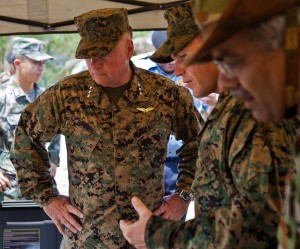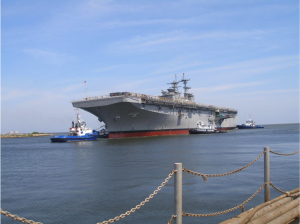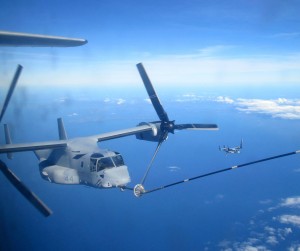2014-03-29 By Robbin Laird
Following my visit to Australia, I had a chance to talk with Lt. General. Robling, the Commanding Officer for the USMC in the Pacific. Soon the Marines are coming for their first rotational force training with the Aussies for the next six months.
Undoubtedly, there will be images in the next few weeks of Marines coming ashore, and training with the Aussies.
But much like a piece I wrote after the Bold Alligator 2012, exercise, these images, although true, do not reflect the true measure of change in Pacific defense.
The key point is that Aussie modernization and that of the USN-USMC team in the Pacific are going on at the same time.
And this convergence of trends is shaping a 21st century approach to Pacific defense.
When I talked with General Carlisle, he outlined what a deterrence in depth strategy in the Pacific to ensure that the US national command authority has options to deal with threats in the region and allies can have confidence in the viability of a vibrant US combat force across the Pacific.
It is clear that the Aussie modernization intersecting with that of the USN-USMC team is at the heart of such a strategy.

The Aussies are modernizing their air and naval forces – C-17s, KC-30A tankers, the Wegetail AEW and C platform, the F-35 along with new capabilities for the frigates, new amphibious ships and new Aegis ships – and are working to integrate those forces for the extended defense of Australia.
The USN-USMC team is shaping a10-year effort, known as the distributed laydown, within which shaping a rotational force to Australia is a key element. The Marines have already brought the Osprey to the Pacific, are coming next year with the F-35B and the Navy is coming this year with the USS America, and all of these platforms will interact through exercises with the Aussies to shape interactive modernization strategies.
During a week of meetings with the MARFORPAC staff prior to the Australian trip, the nature of the distributed laydown was discussed at length. It is a work in progress over the next decade, which is being shaped by opportunities and challenges, as much as by strategic intent.
The distributed laydown started as a real estate move FROM Okinawa TO Guam but it clear that under the press of events and with the emergence of partnering opportunities the distributed laydown has become something quite different. It is about re-shaping and re-configuring the USMC-USN presence within an overall strategy for the joint force and enabling coalition capabilities as well.
The distributed laydown fits the geography of the Pacific and the evolving partnership dynamics in the region. The Pacific is vast; with many nations and many islands. The tragic events involving the missing Malaysian airliner illustrates better than words the vastness of the Pacific and its impacts on operations.
The expeditionary quality of the USMC – which is evolving under the impact of new aviation and amphibious capabilities – is an excellent fit for the island quality of the region. The USMC is building out four major areas to operate FROM (Japan, Guam, Hawaii and, on a rotational basis, and fifth, also on a rotational basis, the Philippines).
But as one member of the MARORPAC staff put it to me: “We go from our basic locations TO a partner or area to train. We are mandated by the Commandant to train our forces, and in practical terms in the Pacific, this means we move within the region to do so. And we are not training forces; we train WITH forces to shape congruent capabilities.”

The basic template around which USMC training activities operate is at the intersection of three key dynamics: the required training for the USMC unit; meeting select PACOM Theater campaign priorities; and the partner nation’s focus or desires for the mutually training exercise or opportunity.
This template remains the same throughout the distributed laydown but it is implemented differently as an ability to operate from multiple locations allows the Marines to broaden their opportunities and shape more meaningful partnership opportunities.
The training regime is translated into a series of exercises executed throughout the year with partner forces. These exercises are central lynchpins in shaping effective working relationships in the region, which provide the foundation for any deterrence in depth strategy.
Nature abhors a vacuum and if you are not present you are absent.
And by building out core working relationships, there is not a significant power void, which can be filled in by powers trying to reshape the rules of the game, and to perhaps impose a new order in the Pacific.
According to Lt. General Robling: “It is not about building relationships in the region. It is about collective security in the region. It is about building real capabilities and capacity with partners and allies. It is not about simply showing up.”
He highlighted that the Aussies are a good example of an ally building out its capabilities as the US does so and working out a very interactive and mutually reinforcing defense structure. He emphasized that the impact of a fleet of F-35s being shaped by Japanese, Singaporean, South Korean and Aussies with those of the USAF, USMC and USN will be a key element of shaping interactive capabilities.
The USMC is a very cost effective force within the overall defense budget spending over all less than 10% of the defense budget. 2/3s of the USMC force is deployed to the Pacific. And in the Pacific the USMC spends $50 million per year on its exercises and of that 50% of the cost is for lift. It is clear that this touchstone for an ongoing commitment and deepening of partner working relationships needs to be fully supported and enhanced in the years to come and not be part of salami cutting approach to cutting defense expenditures.
Filling power vacuums by ongoing presence is a lot more effective than having to rush in later to deal with a crisis generated by collapse or someone else trying to force their will in the region.

Another way to look at the distributed laydown is to compare the before and after of the process. A key aspect of understanding the after is that it is a work in progress and is bound to change in the fluid decade ahead as needs become redefined and new partnership opportunities identified.
The Marines have been directed through International Agreements, spanning two different US administrations to execute force-positioning moves. This is political, but it’s not partisan.
The U.S. Secretary of Defense has mandated that at least 22,000 Marines in PACOM remain west of the International dateline in the distributed Marine Air Ground Task Force or MAGTF Laydown and he, congress, and the American people are not interested in a non-functional concept for a USMC force.
And, the Obama White House has directed the USMC to make to shift as well of forces from Okinawa to Guam and to a new working relationship with the Australians.
Beyond what is directed, the Marines need to maintain a ready-force in the face of existing training area encroachments, plus they have the requirement for training areas near the new force laydown locations
Within the distributed laydown, the Marines must retain the ability rapidly to respond to crises across the range of demands, from Major Combat operation in NE Asia to low-end humanitarian assistance and disaster relief or HA/DR wherever it occurs.
Each location for the Marines is in transition as well. From Okinawa and Iwakuni, the Marines can locally train in Japan, Korea and the Philippines, as well as respond with “Fight Tonight” capabilities if necessary.
From Guam, the Marines can train locally in the Commonwealth of the Northern Mariana Islands (CNMI) to the north, the Federated States of Micronesia to the south, and Palau and the Philippines to the west. Guam and CNMI provide the Marines something they do not have anywhere else in the Pacific: A location on U.S. soil where they can train unilaterally or with partner nations.
In broad terms, prior to the distributed laydown (ca. 2011), the Marines are located in Japan (25,000 in Mainland Japan and Okinawa), Hawaii (approximately 6,000) and on the West Coast (approximately 45,000 in California and Arizona). With the projected end of the distributed laydown process (ca. 2025), there will be a projected force distribution as follows: Mainland Japan and Okinawa (15,000), Guam (approximately 4700), Hawaii (approximately 8800), West Coast (approximately 43,000) and a rotational force in Northwest Australia of approximately 2500).
But this is clearly a work in progress.
What it is NOT is simply moving Marines from Okinawa to Guam. There are additive elements as well, mainly from USMC aviation assets as the USMC delivers new capabilities to the Pacific in the decade ahead.
Lt. General Robling underscored the clear cross cutting relationship between USN-USMC modernization and those of the core allies. He noted with regard to the US-Australian evolving relationship the following:
The two allies see a mutually beneficial relationship. The intersection of Australian training ranges with those we are modernizing in Guam is a key element of working cross cutting modernizations.
This will allow us to work with a set of allies in the region as well within the Guam context to facilitate mutual modernizations of the allies as well.
We are not just building our bilateral relationships; we are facilitating multi-national collaboration AMONG our allies as well.
This is a clear force multiplier.
A key aspect of this working relationship in progress is the ability of the coalition forces to exercise together, and to shape convergent concepts of operations. In the case of the F-35 it is not about parallel air modernization: it is about reshaping joint capabilities for the ground, air and naval forces. Indeed, the Pacific fleet of F-35s will emerge as a force do to exercises in Guam and other locations in the Pacific.
It is about what allies are bringing to the effort; not just the US bringing the capability and allies providing territory. It is about allies modernizing 21st century naval and air capabilities highlight interactive with the US modernization approach as well.

A good example of the change is the Aussies deploying Wedgetail, a more advanced system than the USAF currently has available. This aircraft represents the next generation of AWACS and is the E-10 the USAF did not buy.
As Lt. General Robling put it:
“My good friend Hawk Carlisle will tell you that we would wish to have Wedgetail in our force. This is a high-end capability, which the Australians are bringing to their own force and to the coalition as well.”
An important element of the shift is that the US, clearly the most important player in an allied system of Pacific defense, is becoming a facilitator as well as enabler of allied capabilities. The image of the shift was well illustrated by this comment from a PACAF staffer involved in the exercise process:
“Our role as a facilitator is growing in broadening the engagement opportunities for allies to work together. A good image of the change is that an Aussie Wedgetail was doing to Command and Control for Japanese and South Korean jets at the recent Red Flag exercise. For the first time, South Korean jets crossed through Japanese air space to come to fly with the participants in Red Flag.”
In short, the distributed laydown over the decade ahead is a foundational element in shaping a more effective deterrence in depth approach.
And one, which is inextricably intertwined in reshaping with US allies an effective Pacific, defense approach for the 21st century.
Editor’s Note: There are two more pieces to come further developing the themes in this article. The first is a comprehensive overview of the distributed laydown built on extensive discussions with the MARFORPAC staff and Lt. General Robling. The second is the complete interview with the MARFORPAC commander from which some snipets were introduced for use in this article.


